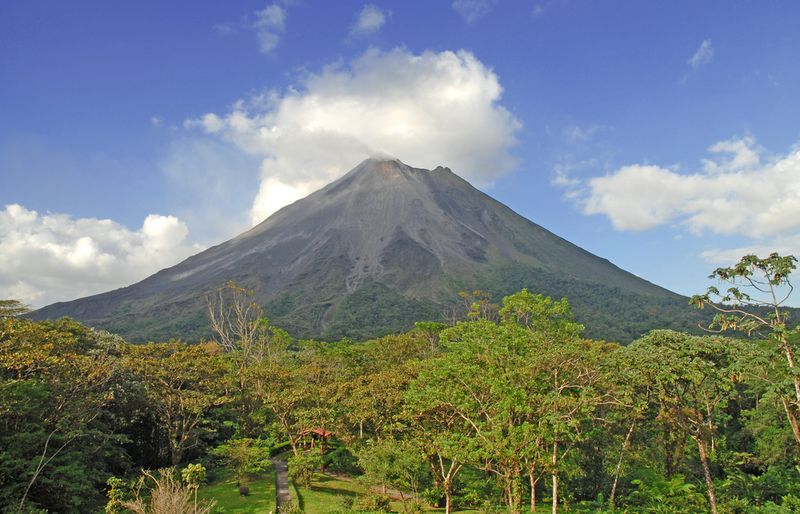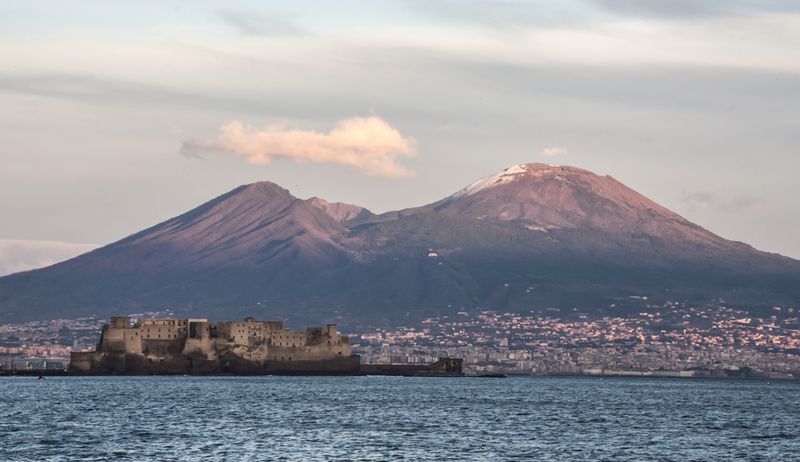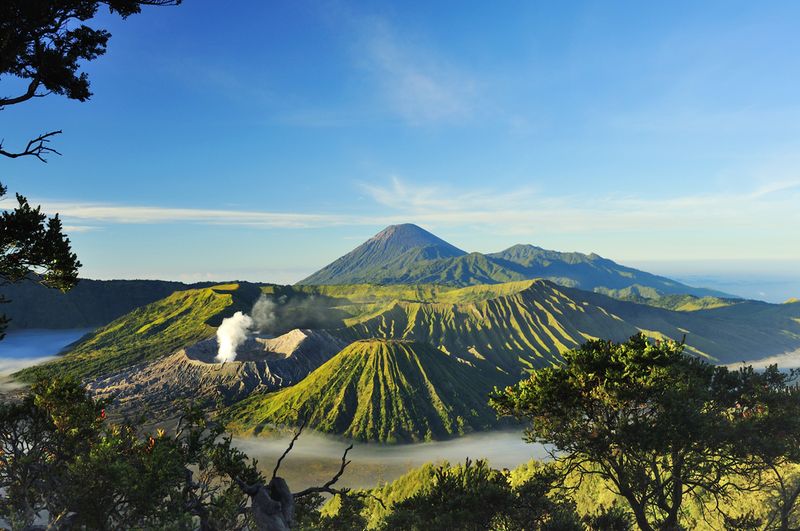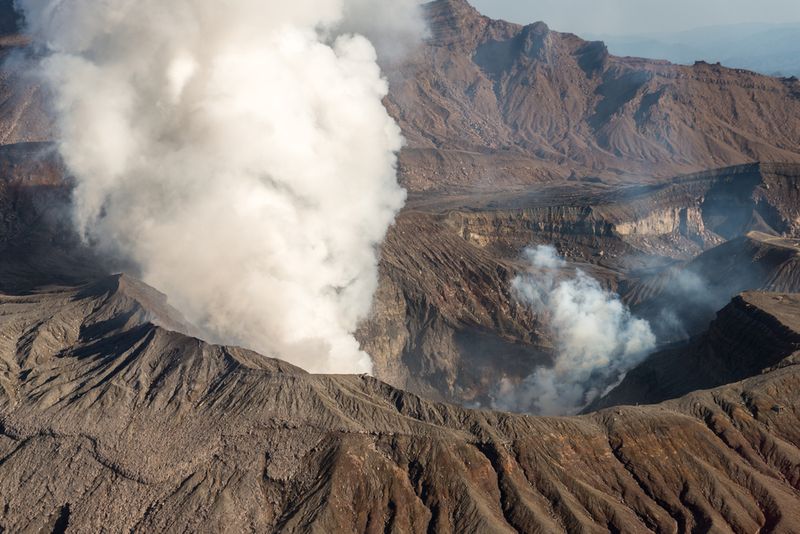
What does it take to climb a volcano? In some cases it takes permits purchased months in advance, technical climbing skills and a paid guide. In other cases one can simply drive right into the volcano, or spend an hour hiking up a moderate hill to reach the top. How about the best volcanoes to hike, how do you determine that? We looked at hundreds of volcanoes and determined the 15 best hikes to take based on a number of factors including ease of access, views from the top, lava activity and the reward factor. From around the world, here are our top 15 choices for the best volcano hikes in the world.
Advertisement
15. Eyjafjallajokull, Iceland
This long but challenging hike takes trekkers through scenic landscapes including snow, ice and ash from the most recent eruptions. The trek starts at sea level and goes all the way to the top through a crevasse riddled glacier and finally to the summit where you can view an enormous crater that was left by past eruptions. Glacier equipment such as crampons are required as you literally will be climbing on ice. If you happen to reach the top on a clear day, expect unbelievable views of half the entire island including glaciers, more volcanoes and the Vestmannaeyjar islands. April to September is the time to go and if you are feeling extra adventurous it is possible to ski back down. The climb can take eight to 10 hours and although challenging, you will certainly feel on top of the world on this glacier volcano.

14. Arenal Volcano, Costa Rica
Arenal was one of the most active volcanoes from about 1968 to 2010 and since then has slowed down but this volcano still is known to spit out ash and sometimes even lava. It is classic in shape, being tall and symmetrical and there is no worry about being cold up here. Climbing to the summit of this volcano is actually both illegal and very dangerous, but luckily there are a few worthwhile hikes that are totally legal and still get you up on the mountain. The main trial inside the park is about 5 km in length and takes you through the rain forest with several opportunities to view the peak. Expect lots of wildlife including toucans and monkeys along with explosions from the peak. Expect to hike over old lava flows and hit many viewing areas where you can actually hear the volcano breathing, which is really quite impressive.

13. Mount Fuji, Japan
It is the highest volcano and highest peak in Japan where tourists and locals’ alike swarm to climb this volcano, known as one of the three Holy Mountains. More than 200,000 people a year to be exact. The last eruption of Mount Fuji occurred in 1707 and spread ash as far as what is now Tokyo forming a new crater on the east flank. July to September is the official climbing season where trails and mountain facilities are open. The most popular way to climb this volcano is to climb halfway up to one of the huts, take a break and set off again in the night, reaching the summit for sunrise. Worshipping the sun from the top of Japan’s highest peak creates something of a spiritual experience, no matter if you are religious or not. Avoiding the crowds is not possible on this mountain and some trekkers believe that climbing amongst so many like minded people just adds to the overall experience.

12. Mount Etna, Sicily
The largest active volcano in Europe, Etna soars into the sky often surrounded by mist and steam. Mount Etna is special in that it has this unique relationship with the people that live as the foot of it. They believe that Etna gives them fertile ground by spitting out lava and respect must be granted as it can also take away life. This volcano can be climbed year round and does not require any sort of permit or guide, but it is recommended to be informed about the activity status as it sometimes shuts down to hikers. It has recently come to the attention of many trekkers that the actual summit is unavailable to anyone who doesn’t have a guide, but that fact is up for debate. Plan on seeing solidified rivers of lava, views of the sea and the mainland, provided the top isn’t covered in clouds.

Advertisement
11. Pacaya, Guatemala
You aren’t allowed quite to the top of this volcano but it should be on your list of things to climb for a number of reasons. First up, this trek can be done in half a day, which makes it perfect for someone on a time crunch. Secondly, not only are you climbing on an active volcano but you can actually see a second active volcano nearby and a third that is now a crater lake. The trek begins through lush green foliage and views are of surrounding fields and hills. The trail eventually turns into lava rock and dust, becoming really slippery. This is when it pays to have a walking stick. At the “top” the lava is literally running underneath you and it becomes clear as to why you need shoes with really good soles, they will literally melt. Marshmallows and hot dogs are routinely busted out and cooked over the lava.

10. Mount Vesuvius, Italy
This volcano is known worldwide as being responsible for covering the city of Pompeii with a blanket of ash in 79 A.D., which in turn preserved it until the re-discovery of it in the 1700’s. Since that time this volcano has blew its top more than 30 times throughout history and most recently in 1944. The climb to the summit is the easiest climb on this list and only takes about 30 minutes. It is best done in hiking shoes or running shoes and there is no need to carry any gear with you. What awaits visitors at the top is a stunning panorama of the city, islands and part of the Apennine Mountains. Admission to the volcano actually includes a guided tour of the crater at the top which many climbers are unaware of. You won’t find any spewing lava here but steam is often seen coming out of the crater. On a sunny day expect to see views out to the bay of Naples. If you are wanting to climb a famous volcano and don’t want to worry about tackling snow, steep ridges or carrying gear; this is the one for you.

9. Pinatubo, Philippines
This active volcano is actually located on the island of Luzon in the Philippines and last erupted in 1991, producing one of the most violent eruptions of the 20th century. As of now the volcano is quite quiet and it is the perfect time to summit and enjoy the blue green crater lake that didn’t exist 30 years ago. January is the best time to go as temperatures are at the coolest and the lake color at its finest. The one day trek is actually quite easy as a 4X4 will take you part of the way. The trek is done within a few hours at a moderate incline. If one desires it is actually possible to pitch a tent at the summit and spend the night, an outhouse is even provided at the top. Hikers will make their way up the path, passing sandy cliffs along the way as well as small tribes of indigenous people.

8. Kilauea, Hawaii
Located on the Big Island, Kilauea is the world’s most active volcano and one of the most easily accessible. In the 20th century alone this volcano has erupted on 45 separate occasions with the most recent eruption beginning in 1983. To date this eruption continues and has spewed over 32 billion cubic yards of lava, forever changing the landscape. You can actually drive into this volcano, but hiking throughout is most recommended as it’s one of the only places on earth you can literally walk through an active volcano. Walking around Crater Rim Drive is one of the most popular activities as you can witness lava oozing out of it, witness steam vents and walk across the land that is only a few days old. There are numerous hiking trails throughout and although one can’t plan a visit around when and where to see the lava, helpful guides at the visitors center will point you in the right direction.

7. Mount Stromboli, Aeolian Islands
Hiking up this volcano is only permitted with a guide and there is a strict limit on how many people are allowed to visit the crater each day, thus make sure to book your trip in advance. The trip to the top isn’t for the faint of heart and will take anywhere from two to four hours to reach the summit. The most popular time to reach the top is at nighttime and thus more tours leave around 4 pm. A gentle incline awaits hikers at first, taking you through lush vegetation. It quickly becomes steeper and one should expect to walk through volcanic sand that is strewn with black rocks. There are actually three craters at the top that billow out steam and smoke, making strange gurgling sounds. The light show at the top is what everyone waits for though as the craters explode with red fiery sparks, shooting high into the air.

Advertisement
6. Mount Bromo, Indonesia
Indonesia is home to over 100 active volcanoes and daily earthquakes, making it a popular place for adrenaline junkies and hikers alike. Although Mount Bromo isn’t the tallest of the active volcanoes in Indonesia, it is the most visited and is quite easily accessible. The volcano has a constant stream of white smoke coming out of it, reminding visitors that it could explode at any time. Getting to the summit is easy without a guide and is best done in time to see the sunrise, meaning a 3 am wake up call is necessary. The well-defined path up should only take you an hour or so. An interesting fact about this volcano is that the Tengger people believe that in order to appease the Gods here they must offer food and money to them by throwing it into the crater of the volcano during the annual Kasada festival.

5. Cotopaxi, Ecuador
It is the second highest peak in Ecuador, lovely looking with its white snow and cone shape. This trek is not for inexperienced hikers though as it is more of a mountain climb than just a hike up the side. In the 18th and 19th century this volcano had a violent spell but now it is mostly just a plume of steam that comes out the top and melts its glacier surroundings. To get here most climbers take a 4X4 up to the border of the national park. They then climb with their guide up to a mountain hut and spend the night, summiting the next morning. It is currently illegal to climb to the summit without a guide and recent signs of eruption have limited the climbing that is allowed. If you have the chance though, summiting the world’s third highest active volcano is certainly something to put on the bucket list.

4. Mont Pelee, Martinique
In 1902 this dramatic volcano erupted and destroyed the entire town of St. Pierre killing about 30,000 people. Luckily since then you can climb this volcano without worries and without tourists at every bend in the trail. Being an integral part of France, visitors climbing here face no red tape or fees but will need some French to get by as English is not widely spoken. Because of the immense vegetation on the island there are three established routes that trekkers can take. The most popular of these is the Aileron Route as it is a well-constructed and wonderfully varied trail. Climbing before dawn is recommended as the clouds roll in day after day just after dawn and prohibit hikers from the magical views that await. Gorgeous lush green vegetation, flowering plants and jagged peaks surprise visitors along the way of this volcano that really looks nothing like the grey, lava strewn volcanoes you are used to.

3. Telica Volcano, Nicaragua
Nicaragua is full of volcanoes, both dormant and active and it can be hard to choose which one to climb but we highly suggest heading to Telica. The majority of the way up tends to be flat, through farm lands and over dirt roads. It is only the last hour or two where you finally start to hike to the top. The best season for climbing this mountain is up for debate as the dry season tends to be hot whereas the rainy season can make the lava harder to witness. Camping at the top of Telica is one of the most popular trips to do as seeing the lava at night is something special and the sunrise in the morning is truly spectacular. The lava is below the crater rim at a depth of about 120 meters and visitors should expect to have to lie down on their stomachs to look into the crater.

2. Mount Aso, Japan
It is Japan’s largest active volcano and climbing it is certainly an adventure that should be on the top of your bucket list. There are three trails you can use to get up to the summit, with one of them not actually leading up to the volcano (hint: do not take the left trail). The hike itself can take anywhere from an hour or three depending on which trail and how many stops you take along the way. There are actually five separate volcanic peaks here and Mt. Nakadake is the most active spewing a constant stream of sulfuric gas from its peak. If you are feeling really lazy and still want to get to the top of the volcano, there is a choice of two cable cars that will get you there.

Advertisement
1. Mount St Helens, United States
It is mandatory to have a permit to hike this active volcano, no matter what time of year and there are only a number of permits that are handed out each year if you want to make it to the top of the crater. Although it is not a technical climb it is strenuous and presents hazards such as ice, loose boulders and fast-changing weather. The scene at the top is what people climb for an it has been described as ‘surreal, unbelievable and awe-inspiring’. A huge crater with a dome that grows in size each year and has a horseshoe glacier around it, not to mention incredible views of Mount Adams, Mount Hood and Mount Rainier, as well as the blue green hills that surround them are all sights to take in from the top. This is truly one of the best volcano hikes in the world and must be at the top of your list to climb.

Advertisement